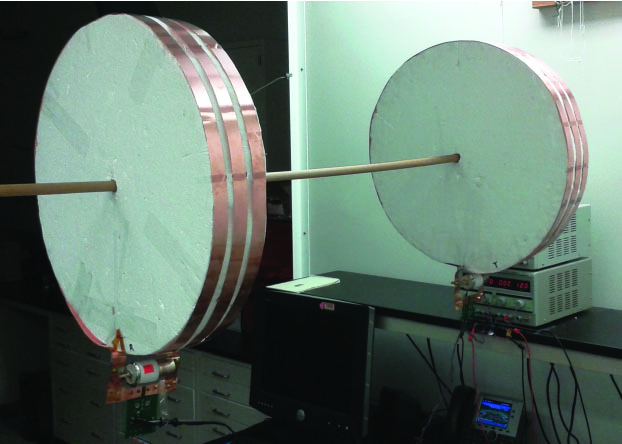
By Brian Santo, contributing writer
It’s way too early for this year’s Gumball Rally, or even next year’s, but soon enough, it might be practical to participate in a 3,000-mile race with an electric car. Researchers at Stanford University have just figured out an entirely new technique for beaming electricity to a moving object.
So far, they’ve only managed to transmit a milliwatt, and only to an LED light bulb moving within a circle with a 1-meter radius, but doing it at all represents overcoming a very high hurdle.
The notion of wireless powering is an old one, dating back at least to Nikola Tesla and his transmission tower on Long Island. Tesla failed, but nearly 100 years later, the electronics industry has figured out how to wirelessly power various smaller items that consume modest amounts of power, such as personal electronics and implanted medical devices .

There are companies working on technologies that might make it possible to radiate power to all household electronics, and if they’re successful, they’ll minimize, and perhaps even eliminate, the need for household power sockets. But getting power to objects in motion — cars, robots, and drones — has been a tough nut to crack. Anything electronic and mobile has needed its own battery pack that has to be recharged at intervals. The need to recharge fully electric vehicles is one of the things holding them back from greater market acceptance.
Researchers at Stanford University have created what they describe as a “parity–time-symmetric circuit incorporating a non-linear gain saturation element,” which they say provides robust wireless power transfer. Their approach achieves transfer efficiency near unity at 1 meter without the need for tuning. The practical manifestation of unity in the demo is that the brightness of the light bulb remains steady regardless of where it is. In contrast with other systems, its brightness does not diminish with distance.
The researchers assert that all previous wireless systems for power transmission at a distance require constant retuning of either “the frequency or the internal coupling parameters as the transfer distance or the relative orientation of the source and receiver units is varied,” according to their paper, published in a recent issue of Nature .
The basic phenomenon being exploited is magnetic resonance coupling. If you take two similar coils, put them in proximity, and hit one with radio waves, the other coil will couple with it and the two will act like a single circuit, with the first transferring power to the second. But the relationship is dependent on the distance of the two coils; if the distance changes, the system has to be retuned.
The difference with the parity-time-symmetric circuit is that it incorporates a voltage amplifier and a feedback resistor in the first coil, creating a phenomenon likened to a feedback in an audio system.
“Adding the amplifier and resistor allows power to be very efficiently transferred across most of the three-foot range and despite the changing orientation of the receiving coil,” graduate student Sid Assawaworrarit told the Stanford News . Assawaworrarit is the lead author of the paper published in Nature. “This eliminates the need for automatic and continuous tuning of any aspect of the circuits.”
The group that developed the system for powering implanted medical electronics is also based at Stanford. This group thinks that their technology could be used for the same set of applications. But if it can be improved, it might be possible to power electric vehicles while they’re on the go by embedding arrays of coils in roadways that would charge vehicles as they pass over the arrays.
There’s at least one other technique for doing something similar. Qualcomm has a different technology that it calls Halo WEVC (wireless electric vehicle charging).
Advertisement
Learn more about Electronic Products Magazine





